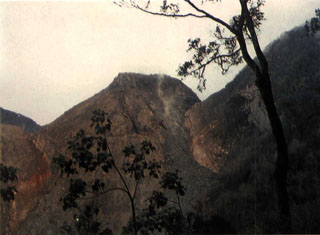Report on Ranakah (Indonesia) — January 1988
Scientific Event Alert Network Bulletin, vol. 13, no. 1 (January 1988)
Managing Editor: Lindsay McClelland.
Ranakah (Indonesia) Explosions and lava from newly active volcano
Please cite this report as:
Global Volcanism Program, 1988. Report on Ranakah (Indonesia) (McClelland, L., ed.). Scientific Event Alert Network Bulletin, 13:1. Smithsonian Institution. https://doi.org/10.5479/si.GVP.SEAN198801-264071
Ranakah
Indonesia
8.637°S, 120.5302°E; summit elev. 2288 m
All times are local (unless otherwise noted)
Numerous explosions from 28 December 1987 to 9 January 1988 sent ash columns to 500-6,000 m height. There was no evidence of new magmatic material in the deposits through 9 January but a glow above the crater was noticed that day. Two days later, lava was visible within the crater. The arrival of lava coincided with a change in signals recorded by portable seismographs: from A-and B-type earthquakes to rockfall avalanches on 9 January. Only rockfalls have been recorded since then.
Between 10 and 14 January lava nearly filled the crater. Numerous large explosions, originally from rockfall avalanches off the new dome N into the steep-walled Wai Reno drainage, were reported on 12 and 13 January. The largest, at about 0530 on the 12th, produced a nuée ardente d'avalanche that traveled ~ 5 km N down the Wai Reno drainage. It knocked over and singed trees in an area of dense jungle as much as 1 km wide before stopping 700 m from the highway. After 14 January large avalanche explosions greatly diminished and lava began creeping into the Wai Reno drainage. From 14 to 21 January, most growth was in the flow rather than in the dome. On 22 January the flow was ~ 300-350 m long, 200 m wide, and 40 m thick, with a volume of 2.5-3.0 x 106 m3. Lava dome volume on 23 January was roughly 5 x 106 m3, and another 1.5 x 106 m3 of new lava was estimated to have fallen from the flow and dome as rockfall avalanches. At the end of January the lava dome was protruding ~100 m above the crater rim (~150-170 m above the floor of the crater).
On 22 January at 0520 a large rockfall avalanche from the E margin of the dome moved ~ 0.5 km E into the valley between Ranakah and Mandasowu. It flattened dense jungle E of the dome and stripped and singed leaves at its perimeter. The avalanche was sufficiently mobile to follow a narrow NE drainage around a small hill (Bukit Timur) before sending a little material into the Wai Reno drainage. Rockfalls from the N lava lobe diminished after 23 January and most new lava continued to flow from the dome into the flat area to the E. Rates of lava extrusion averaged roughly 500,000 m3/day. As of 26 January, 4,200 inhabitants of the sparsely populated area N of Anak Ranakah had been evacuated to the city of Ruteng (population ~ 49,000). A VSI observation post has been established at Poka village, ~7 km NNW of the vent. Three radio-telemetered seismometers have been installed on the N side of the Wai Reno drainage.
A VSI field party observed evidence for at least three former episodes of block and ash avalanching from prehistoric domes or flows into the Wai Reno drainage. In hand specimen, these lavas were characterized as plagioclase-andesite to dacite with differing proportions of hornblende, plagioclase, biotite, and pyroxene.
Geological Summary. The Anak Ranakah (Child of Ranakah) lava dome was formed in 1987 in an area without previous recorded eruptions at the base of the large older lava dome of Gunung Ranakah. An arcuate group of lava domes extending about 12 km west from Gunung Ranakah to Poco Mandosawa occurs on the outer N flanks of the poorly known Poco Leok caldera on western Flores Island.
Information Contacts: VSI.

